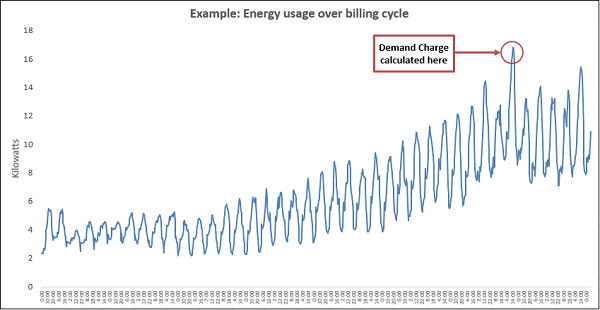Electricity Demand Charges and Solar Energy
Solar PV installations will in most cases reduce peak demand charges but there are a lot of dependencies and it is impossible to guarantee this saving. So treat any business case that includes a peak demand saving with care! This article attempts to explain how solar can impact the demand charge.
Other names for a demand charge: Peak Demand Tariff, Capacity Charge, etc.
What is a Demand Charge?
In addition to a usage charge and a network supply charge, commercial customers typically face an additional charge for the peak demand during the period. This is often calculated as the highest or peak 15 minute period that you use during the billing cycle.
These peak charges have been subject to the greatest price increase over the last decade and can represent a large percentage of the total bill.
How Can Solar Reduce the Demand Charge?
The concept is fairly simple – by producing your own energy, if your peak demand was during the day then you should be offsetting a portion of your usage therefore shifting you to a lower demand tariff with your electricity provider. However, without batteries, it is not possible for Solar PV to guarantee these savings.
You may still result in the same high demand for the month if:
- Your peak load occurs at night time when solar is not producing power
- There is a cloudy period during the day that limits the potential of your solar output
We suggest that peak demand savings are not modelled as part of a Commercial Solar PV business case and rather the benefits should be considered a bonus. Fortunately most business cases look attractive enough simply by offsetting energy consumption.
Can Solar Batteries Help?
A well-designed battery solution can provide much greater certainty around the peak demand savings. It can tackle both problems reference above by providing energy at night time and during rainstorms. Battery solutions utilise clever software that tells your appliances where to draw power from. A priority is usually established meaning that power is drawn directly from the solar first, then from the battery bank and lastly from the grid. As solar batteries are still comparatively expensive, these solutions generally suit companies with a longer term view towards investing in their energy solution.
- Solar Panel Costs: Solar Choice Price Index | April 2025 - 1 April, 2025
- Solar Panels For Homes – All You Need to Know About Solar Systems - 18 March, 2025
- Best NSW Solar Feed-In Tariffs - 17 March, 2025
